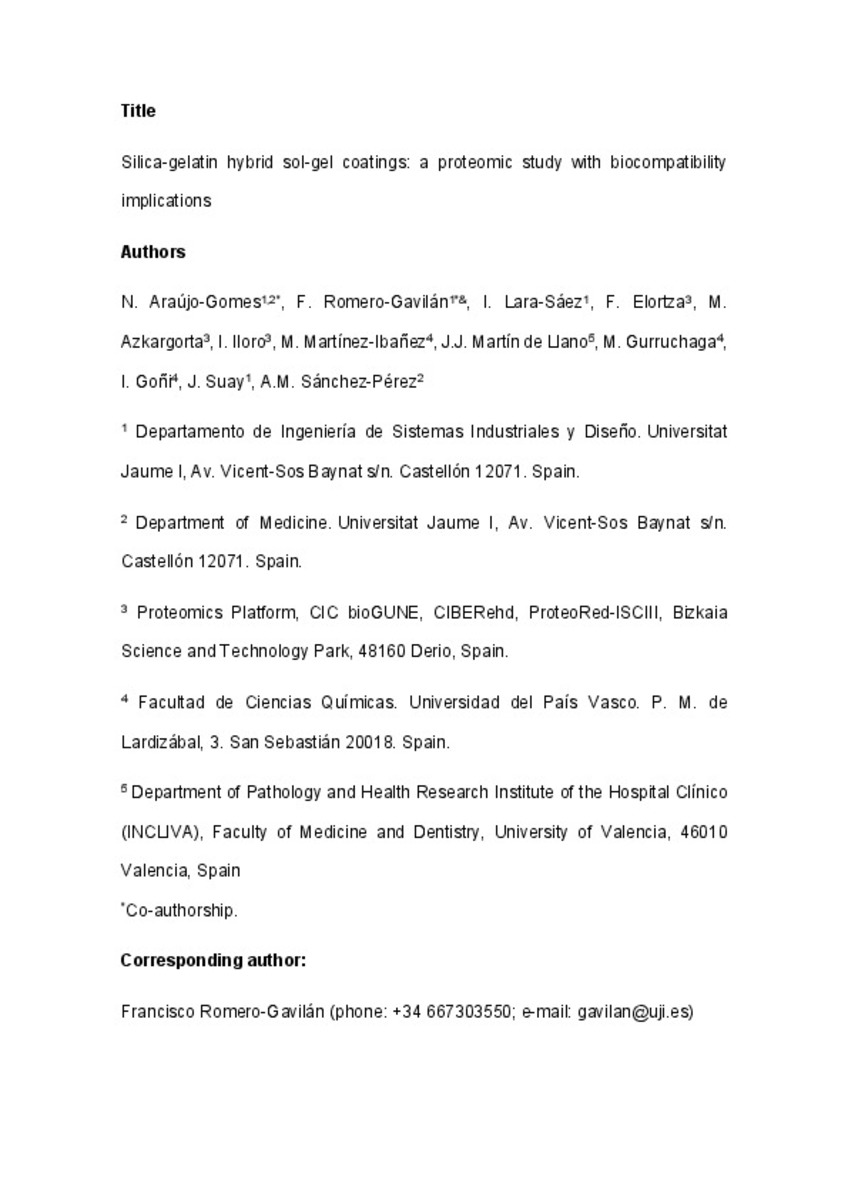Mostrar el registro sencillo del ítem
Silica-gelatin hybrid sol-gel coatings: A proteomic study with biocompatibility implications
| dc.contributor.author | Gomes, Nuno | |
| dc.contributor.author | Romero-Gavilán, Francisco J | |
| dc.contributor.author | Lara, Irene | |
| dc.contributor.author | Elortza, Felix | |
| dc.contributor.author | Azkargorta, Mikel | |
| dc.contributor.author | Lloro, Ibon | |
| dc.contributor.author | Ibáñez, Maria | |
| dc.contributor.author | Martín de Llano, J. J. | |
| dc.contributor.author | GURRUCHAGA, MARILO | |
| dc.contributor.author | Goñi, Isabel | |
| dc.contributor.author | Suay, Julio | |
| dc.contributor.author | Sánchez-Pérez, Ana María | |
| dc.date.accessioned | 2018-11-05T11:30:00Z | |
| dc.date.available | 2018-11-05T11:30:00Z | |
| dc.date.issued | 2018-05 | |
| dc.identifier.citation | ARAÚJO‐GOMES, Nuno, et al. Silica–gelatin hybrid sol–gel coatings: A proteomic study with biocompatibility implications. Journal of tissue engineering and regenerative medicine, 2018, 12.7: 1769-1779. | ca_CA |
| dc.identifier.uri | http://hdl.handle.net/10234/177206 | |
| dc.description.abstract | Osseointegration, including the foreign body reaction to biomaterials, is an immune‐modulated, multifactorial, and complex healing process in which various cells and mediators are involved. The buildup of the osseointegration process is immunological and inflammation‐driven, often triggered by the adsorption of proteins on the surfaces of the biomaterials and complement activation. New strategies for improving osseointegration use coatings as vehicles for osteogenic biomolecules delivery from implants. Natural polymers, such as gelatin, can mimic Collagen I and enhance the biocompatibility of a material. In this experimental study, two different base sol–gel formulations and their combination with gelatin were applied as coatings on sandblasted, acid‐etched titanium substrates, and their biological potential as osteogenic biomaterials was tested. We examined the proteins adsorbed onto each surface and their in vitro and in vivo effects. In vitro results showed an improvement in cell proliferation and mineralization in gelatin‐containing samples. In vivo testing showed the presence of a looser connective tissue layer in those coatings with substantially more complement activation proteins adsorbed, especially those containing gelatin. Vitronectin and FETUA, proteins associated with mineralization process, were significantly more adsorbed in gelatin coatings. | ca_CA |
| dc.format.extent | 35 p. | ca_CA |
| dc.format.mimetype | application/pdf | ca_CA |
| dc.language.iso | eng | ca_CA |
| dc.publisher | Wiley | ca_CA |
| dc.rights | Copyright © 2018 John Wiley & Sons, Inc. All rights reserved | ca_CA |
| dc.rights.uri | http://rightsstatements.org/vocab/InC/1.0/ | * |
| dc.subject | dental implants | ca_CA |
| dc.subject | biocompatibility | ca_CA |
| dc.subject | biomaterial | ca_CA |
| dc.subject | immunology | ca_CA |
| dc.subject | complement pathway | ca_CA |
| dc.subject | bone regeneration | ca_CA |
| dc.title | Silica-gelatin hybrid sol-gel coatings: A proteomic study with biocompatibility implications | ca_CA |
| dc.type | info:eu-repo/semantics/article | ca_CA |
| dc.identifier.doi | https://doi.org/10.1002/term.2708 | |
| dc.relation.projectID | MINECO (MAT2017‐86043‐R) ; Universitat Jaume I (UJI‐B2017‐37 and grant Predoc/2014/25) ; Generalitat Valenciana (grant Grisolia/2014/016) ; Basque Government (IT611‐13 and grant Predoc/2016/1/0141) ; University of the Basque Country (UPV/EHU) (UFI11/56) | ca_CA |
| dc.rights.accessRights | info:eu-repo/semantics/openAccess | ca_CA |
| dc.relation.publisherVersion | https://onlinelibrary.wiley.com/doi/full/10.1002/term.2708 | ca_CA |
| dc.type.version | info:eu-repo/semantics/sumittedVersion | ca_CA |
Ficheros en el ítem
Este ítem aparece en la(s) siguiente(s) colección(ones)
-
MED_Articles [637]
Articles de publicacions periòdiques -
ESID_Articles [463]







